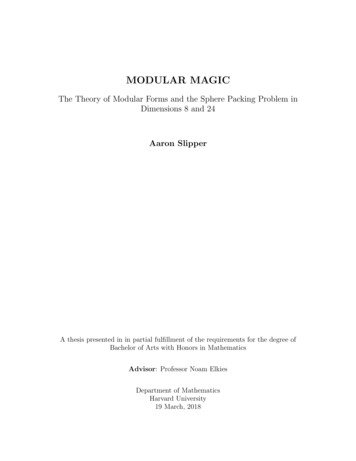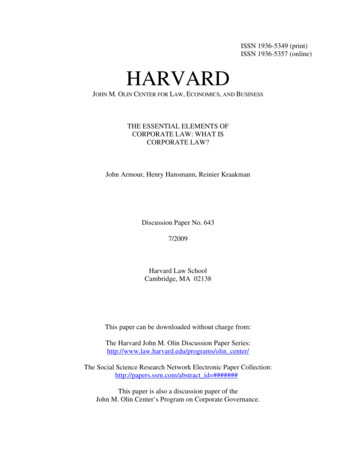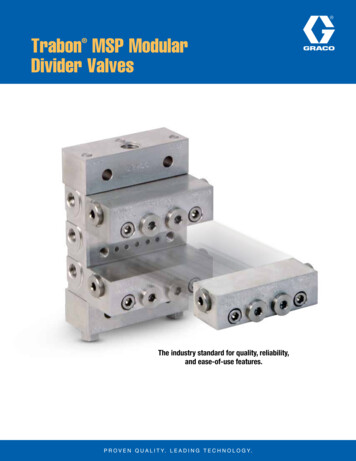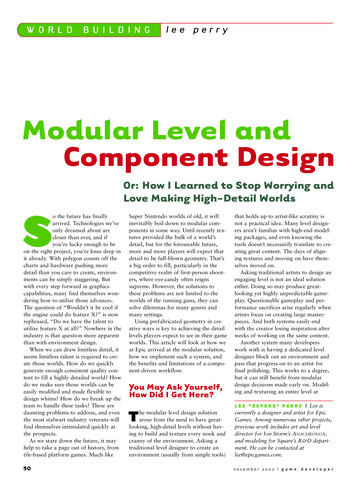
Transcription
MODULAR MAGICThe Theory of Modular Forms and the Sphere Packing Problem inDimensions 8 and 24Aaron SlipperA thesis presented in in partial fulfillment of the requirements for the degree ofBachelor of Arts with Honors in MathematicsAdvisor: Professor Noam ElkiesDepartment of MathematicsHarvard University19 March, 2018
Modular MagicAaron SlipperContentsPreface1. Background and History1.1. Some History1.2. Generalities of Sphere Packings1.3. E8 and the Leech Lattice2. The Elementary Theory of Modular Forms2.1. First definitions.2.2. The Fundamental Domain of the Modular Group2.3. The Valence Formula and Finite Dimensionality of Mk (Γ(1))2.4. Eisenstein Series and the Algebra M (Γ(1))2.5. Fourier Expansions of Eisenstein Series2.6. The Non-Modular E2 and Hecke’s Trick2.7. The Discriminant Function 2.8. Theta Series2.9. Ramanujan’s Derivative Identities2.10. Laplace Transforms of Modular Forms and Fourier Eigenfunctions3. The Cohn-Elkies Linear Programming Bound3.1. The Bound.3.2. The Case of Dimension 13.3. Some Numerical Consequences of the Cohn-Elkies Bound4. Viazovska’s Argument for Dimension 84.1. Overview of the Construction4.2. Constructing the 1 Eigenfunction4.3. Constructing The 1 Eigenfunction4.4. The Rigorous Argument4.5. Completing the Proof: An Inequality of Modular Forms5. The Case of 24 Dimensions5.1. The 1 Eigenfunction5.2. The 1 Eigenfunction5.3. The Final Step6. Further Questions and Concluding 546494951606580838485868790PrefaceThis thesis will give a motivated exposition of Viazovska’s proof that the E8 latticepacking is the densest sphere packing in dimension 8, as well as an overview of the (verysimilar) proof that the Leech lattice is optimal in dimension 24. In chapter 1, we give abrief history of the sphere packing problem, discuss some of the basic definitions and generaltheorems concerning sphere packing, and offer constructions of the E8 and Leech lattices.We do not, however, delve deeply into the miraculous properties of these lattices. In chapter2 we give a more or less complete introduction to the theory of modular forms as it will be1
Modular MagicAaron Slipperused in Viazovska’s proof. For those already familiar with this material, it is recommendedto begin with chapter 3. Chapter 3 contains a proof of the Cohn-Elkies linear programmingbound, its application to the trivial 1-dimensional sphere packing problem, and describessome of the numerical results that can be computed from the Cohn-Elkies bound. Chapter 4gives a lengthy discussion of the motivation for Viazovska’s magic function construction andthen a rigorous proof that it works as needed. This chapter contains the main content of thisthesis. Chapter 5 gives a concise overview of the corresponding magic function construction indimension 24. Finally, chapter 6 describes some further questions concerning magic functions,the Cohn-Elkies bound, sphere packing, Fourier Interpolation and the 8 and 24 dimensionalproofs.I would like to offer my deepest thanks to my thesis advisor, Professor Noam Elkies,for his constant assistance to me and detailed commentary, edits and suggestions on thevarious drafts of this thesis. I would also like to thank Henry Cohn for generously takingthe time to meet with me and discuss his work on the sphere packing problem; MarynaViazovska, whose brilliant resolution of the 8-dimensional sphere packing problem is themain topic of this thesis (and who kindly talked to me about her work during the 2017Current Developments in Mathematics forum at Harvard); and Don Zagier, a personal herowhose chapter in The 1, 2, 3 of Modular Forms has inspired me for some time. Finally, Iwould like to thank “The Hicks House Crew”: Michael Fine, Emily Saunders, Chris Rohliček,and Ethan Kripke, my “Gnoccho”, who was of invaluable assistance to me in resolving thesubtle subtraction problem, 256 512 256.1. Background and History1.1. Some History. How does one pack congruent spheres as densely as possible? Thisseemingly innocent question – one that anyone who has tried to pack oranges or stack marblesis already intimately familiar with – turns out to be one of the most tantalizingly difficultproblems in geometry. Spheres, unlike cubes, do not fit together well, and the kinds ofarrangements one can create by trying to pack spheres (and their multidimensional analogues)together are diverse and interesting. Moreover, the theory of sphere packings has fascinatingconnections to other areas of mathematics: quadratic forms, number theory, lattices, finitegroups, and modular forms, to name a few.The central question in the study of sphere packing is to find the largest proportion ofd-dimensional Euclidean space that can be covered by non-overlapping unit balls. For generald, the answer remains unknown; in fact, we do not even know whether the maximally denseconfigurations are lattice packings or even periodic for most d (indeed, heuristic evidencesuggests that optimal packings will likely not be lattice packings for most d [8].The case of sphere packing in everyday 3-dimensional space was of great historicalimportance. It was conjectured by astronomer and mathematician Johannes Kepler, in his1611 paper Strena seu de nive sexangula (‘On the Six-Cornered Snowflake’), that the densestpacking of spheres in 3 dimensions is the so-called face-centered-cubic (FCC) lattice, whichcovers π/ 18 or about 74.05% of 3-dimensional space [21]. The background for Kepler’sinterest in sphere packing is itself an interesting historical footnote. Kepler was inspired tostudy sphere packings by fellow astronomer Thomas Harriot (1560–1621), who was a friend2
Modular MagicAaron Slipperand assistant of the famous explorer Sir Walter Raleigh (1554–1618), the early New Worldcolonist whose doomed ‘Roanoke’ expedition has been the subject of much mystery. It wasRaleigh who had set Harriot the (very practical) problem of finding the most efficient way tostack cannonballs on his ships [36]. One might say that the modern theory of sphere packingand United States of America share a common ancestor.Little progress was made on the so-called ‘Kepler conjecture’ until Gauss [16], in 1831,who proved that Kepler’s packing achieves maximal density among lattice packings of spheres(that is, Gauss showed that we insist upon the centers of the spheres forming a lattice in R3 ,then the FCC is the densest). The question of irregular packings turned out to be of greatdifficulty – indeed, over restricted subsets of R3 it is possible to find irregular packings thatachieve density greater than Kepler’s – but all known examples of these failed to extend toall of R3 .In 1953, László Fejes Tóth (1915-2005), one of the progenitors of discrete geometry(and the theory of sphere packings specifically), demonstrated that, in principle, one couldreduce the problem of irregular packings in Kepler’s conjecture to verifying a finite (butexceedingly large) set of computations; Fejes Tóth himself observed that a computer couldin theory verify all the necessary cases, though at the time, the technology was insufficientto make this method practicable [14].Thomas Hales, a number theorist then at the University of Michigan, was the firstto implement Fejes Tóth’s program. Hales and his student Samuel Ferguson completed thiscomputer-assisted proof by 1998, depending upon the computer-assisted resolution of around100,000 linear programming problems [18]. This proof was as interesting sociologically asit was mathematically – it was the second significant mathematical result to be resolvedthrough exhaustive computer-assisted brute force (the first being the famous four-color theorem, proved in 1976 by Appel and Haken). It represents one of the first computer-ageproofs: an argument that no human knows in full detail, but which establishes the resultwith complete certainty – perhaps even greater certainty than many proofs which are notcomputer-assisted, and so liable to human fallibility. Recently, Hales and collaborators published on the ArXiv a computer-verification of the proof of the Kepler conjecture [19]. It wasaccepted for publication in the journal Forum of Mathematics in 2017.A parallel – though less protracted – story transpired for d 2, the problem of packingcongruent circles as denselyis possible in R2 . Here the hexagonal (honeycomb) circle-packing is optimal, covering π/ 12 or about 90.69% of R2 . Joseph-Louis Lagrange (1736-1813) playedthe analogous role to Gauss in this story, proving that the honeycomb lattice is optimal amonglattice circle packings in R2 ; the first proof that the hexagonal packing is optimal among allpackings came with Axel Thue (1863-1922) in 1890 [37]. Yet, while this result is often called“Thue’s theorem,” there is some contention over whether Thue’s proof is fully correct. Thefirst proof universally acknowledged to be complete was given by Fejes Tóth (1940) [15].This thesis concerns the remarkable recent results which resolve the sphere packingproblem in dimensions 8 and 24. It was proved as early as 1935 that the E8 lattice givesthe densest possible packing among lattice sphere packings in 8 dimensions [2]. However,the proof that the Leech lattice is the densest among lattice packing in 24 dimensions cameas late as 2004 [7]. The 8-dimensional problem for general, possibly irregular packings wassolved by Maryna Viazovska in 2016 [38], and her method was quickly re-purposed to solve3
Modular MagicAaron Slipperthe general sphere packing problem in 24 dimensions [8]. Viazovska’s solution consisted offinding an optimal function for the so-called “linear programming bound” of Cohn-Elkies,which was in turn inspired by similar “linear programming bounds” for kissing numbers anderror-correcting codes. We shall give a brief history of these background developments.A closely related issue to the sphere packing problem, the so-called “kissing numberproblem” acted as an early incubator for the methods and ideas employed in resolving thesphere packing problem in d 8 and d 24. The kissing number in dimension n is definedto be the maximal number of non-overlapping, congruent spheres that can be placed arounda single, central, sphere of the same radius. (The shell of spheres thus “kiss” the sphere inthe middle). In two dimensions, it is fairly clear that one can place six pennies around asingle penny but no more. In 1694, the corresponding question in three dimensions becamethe subject of a famous debate between Isaac Newton (1643-1727) and David Gregory (16611708). Newton believed that only twelve spheres could fit, whereas Gregory believed that athirteenth could be squeezed in. Newton was ultimately vindicated, though the first rigorousproof was given in 1953 by Kurt Schütte (1909-1998) and Bartel van der Waerden (19031996) [34]. Notably, the “fit” of the 12 spheres around the single central sphere (unlike in twodimensions) is very poor – one can, in fact, continuously roll the 12 spheres on the centralsphere without ever lifting the spheres off of the central sphere, and, eventually, swap thepositions of any two spheres.In the beginning of the 1970’s Phillipe Delsarte made a major breakthrough in theclosely related theory of binary codes, where he applied the theory of linear programmingto establish strong upper bounds for cardinalities of error-correcting codes [11]. Delsarte,Goethals, and Seidel soon applied this theory to the case of so-called “spherical codes” (whichcorrespond to finite sets of points on a sphere in some dimension) to give very good upperbounds on kissing numbers [12]. The technique involves constructing a certain auxiliaryfunction with specified properties; given such a function, one can find a corresponding boundon kissing numbers. In the case of dimensions 8, and 24, it was found to be possible forcethese upper bounds to actually equal the kissing numbers coming from known lattice packings(namely E8 in dimension 8; and Λ24 , or the Leech lattice, in dimension 24). With thistechnique Neil Sloane (1939–) and Andrew Odlyzko (1949–) [30] and, independently, VladimirLevenshtein (1935–2017) [22], proved that the kissing numbers in dimension 8 and 24 are 240and 196560, respectively; with these bounds attained by the first shell of the E8 and theLeech lattice sphere packings, respectively.Interestingly, while the Delsarte technique itself was insufficient to solve the kissingnumber problem in 4 dimensions, it turned out that the method could be cleverly modifiedto resolve this case as well. It was known that one could fit 24 hyperspheres around a singlecongruent hypersphere (this is accomplished by the first shell of the D4 lattice packing, whichis also conjectured to be the best sphere packing in dimension 4). However, Delsarte’s methodin four dimensions proved only able to give an upper bound of 25. Oleg Musin found a rathersubtle modification of the Delsarte Method to reduce the bound to 24, thus solving the 4dimensional kissing number problem [28; 27]. Interestingly, Musin then used this techniqueto offer an alternative proof that the 3-dimensional kissing number is 12 [29].In 2003 Henry Cohn and Noam Elkies introduced the technique of linear programmingbounds for sphere packings in analogy with the linear programming bounds used in the theory4
Modular MagicAaron Slipperof error-correcting codes and kissing numbers [6]. Like the Delsarte bound, the Cohn-Elkiesbound depends on finding some auxiliary function subject to certain constraints. Efforts tooptimize the this function revealed that, like with kissing numbers, the Cohn-Elkies boundseemed to actually give the optimal packing density in dimensions 8 and 24. That is, theupper bounds coming from well-chosen functions f could be made to be extremely close to thedensities of the lattice packings E8 and Λ24 . Cohn and Elkies conjectured that there existfunctions which optimize the Cohn-Elkies bounds in these dimensions – so-called “magicfun
MODULAR MAGIC The Theory of Modular Forms and the Sphere Packing Problem in Dimensions 8 and 24 Aaron Slipper A thesis presented in in partial ful llment of the requirements for the degree of Bachelor of Arts with Honors in Mathematics Advisor: Professor Noam Elkies Department of Mathematics Harvard University 19 March, 2018











